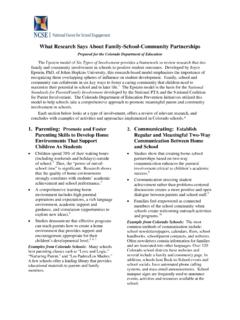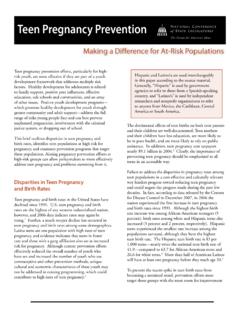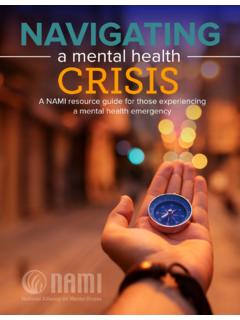Transcription of Pegs FINAL--A Literature Map of Dropout Prevention ...
1 A Literature Map of Dropout Prevention interventions for Students With Disabilities Julia Wilkins National Dropout Prevention Center for Students with Disabilities (NDPC-SD). Clemson University Sloan Huckabee College of Health, Education, and Human Development Clemson University Loujeania Williams Bost Project Director National Dropout Prevention Center for Students with Disabilities Selete Avoke Project Officer Office of Special Education Programs April 2014. Acknowledgments The authors would like to thank the following National Dropout Prevention Center for Students with Disabilities advisory board members for their suggestions and feedback regarding the content of this review: Vangie Aguilera, Charlotte Alverson, Bethann Berliner, Richard Briscoe, Brian Cobb, Debra Duardo, Debra Jennings, Marilyn Johnson, Scott G.
2 Reynolds, David Riley, and Jane Sullivan. We extend gratitude to Dr. Loujeania Williams Bost for her valuable input throughout the development of this document. We also thank Merry P. Chrestman for her exceptional proofreading, editing, and design skills. Additionally, we would like to thank Dr. Angela Prince for her assistance with the search for studies while she was a doctoral student at Clemson University and Dr. Antonis Katsiyannis for his contributions to the coding process. Finally, we would like to recognize Dr. Selete Avoke, OSEP project officer, for his continued guidance and support of the Center's work. This publication is copyright free.
3 While permission to reprint this publication is not necessary, the citation should read: Wilkins, J., & Huckabee, S. (2014). A Literature map of Dropout Prevention interventions for students with disabilities. Clemson, SC: National Dropout Prevention Center for Students with Disabilities, Clemson University. The National Dropout Prevention Center for Students with Disabilities is funded by the Department of Education's Office of Special Education Programs' Cooperative Agreement No. H326W080003. The content herein does not necessarily reflect views or policies of the Department of Education, nor does mention of other organizations imply endorsement by those organizations or the Government.
4 ! A Literature Map of Dropout Prevention interventions for Students With Disabilities Julia Wilkins National Dropout Prevention Center for Students with Disabilities Clemson University Sloan Huckabee College of Health, Education, and Human Development Clemson University ! ! Executive Summary Overview dropping out of school has serious negative outcomes for youth , including an increased likelihood of living in poverty, being unemployed, unhealthy, and incarcerated. Students with disabilities have much higher Dropout rates than general education students and consequently have much poorer adult outcomes. Although Dropout Prevention programs are implemented in many schools, the impact of these interventions is rarely evaluated.
5 The last review of initiatives related to graduation for students with disabilities was conducted in 2004 (with a 2005. publication date; Cobb, Sample, Alwell, & Johns, 2005). This report presents research on Dropout Prevention interventions for students with disabilities, published between January, 2004, and January, 2013. A search of published and unpublished studies turned up 544 studies that appeared from their abstracts to be about Dropout Prevention . However, only 19 studies included students with disabilities in their sample groups and reported outcomes for these students, which were criteria for inclusion in this review.
6 These 19 studies are presented here in a Literature map describing their interventions , outcomes, sample characteristics, and methodological characteristics. Findings The three most common interventions associated with graduating from school described in the studies involved: (a) mentoring, (b) interventions targeted to specific disability-related needs ( , academic, interpersonal), and (c) class setting and exit options. Eleven of the nineteen studies described comprehensive Dropout Prevention programs that had multiple components. interventions reflected many of the same practices identified by The Institute of A Literature Map of Dropout Prevention interventions for Students With Disabilities !
7 Education Sciences (IES) as effective Dropout interventions for general education students (Dynarski, Clarke, Cobb, Finn, Rumberger, & Smink, 2008). In line with Dynarski et al.'s (2008). recommendations, most of the comprehensive Dropout Prevention programs provided mentoring, academic supports, and instruction on positive behaviors, social skills, and character development. Programs also focused on engaging students through relevant instruction and skills students would need after school, through job training, career awareness, and exposure to postsecondary education. Several of the studies also described programs that provided a personalized learning environment with individualized instruction.
8 Implications While the interventions described in these 19 studies appear promising for increasing graduation rates for students with disabilities, only three studies were conducted using experimental designs. By using a treatment and control group, experimental studies have advantages over other research designs in that they provide estimates of the impact of a given intervention. In addition, only five studies reported effect sizes, which indicate how much of a difference the intervention made. In terms of the sample groups, in four studies, students were just described as having special education status and their specific disabilities were not described.
9 Three studies did not report the gender or racial/ethnic make-up of the sample group. Overall, this Literature map points to the need for more experimental research into effective Dropout Prevention initiatives that increase the graduation rates of students with disabilities and the need to disaggregate sample characteristics by demographic features, including disability and race/ethnicity. Policy recommendations include increasing flexibility regarding the length of time allowed for students with disabilities to obtain a high school diploma. A Literature Map of Dropout Prevention interventions for Students With Disabilities ! Table of Contents Page Abstract.
10 I Introduction .. 1. The Need for a Review of Dropout Intervention for Students With Disabilities .. 2. Objectives .. 3. Who Is a Dropout ? . 3. Research Questions 4. Procedures .. 4. Search Strategies 4. Sources .. 5. Selection Criteria .. 6. Coding Protocols .. 9. Results . 10. Research Question 1 .. 13. interventions .. 14. Mentoring .. 14. interventions Targeted to Students' Specific Disability-Related Needs .. 18. Classroom Setting and Exit Options .. 21. Outcome Measures and Research Designs .. 22. Research Question 2 .. 28. Research Designs and Disabilities .. 28. interventions and Disabilities 29. Research Designs, Gender, and Race/Ethnicity 30.




